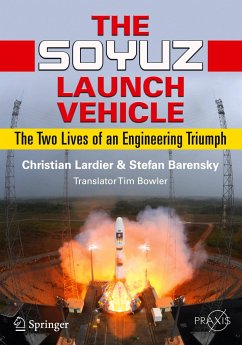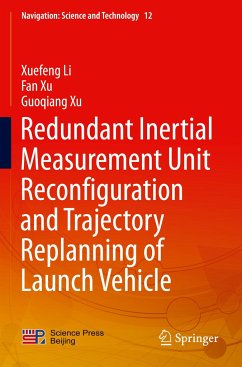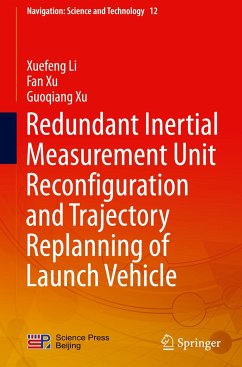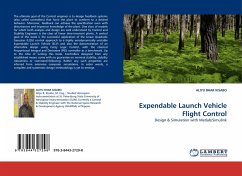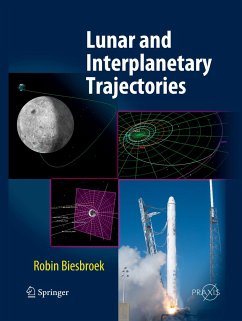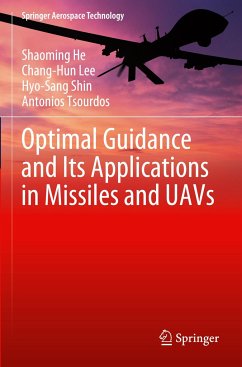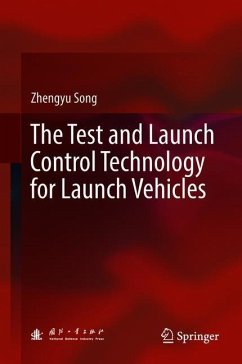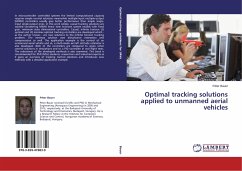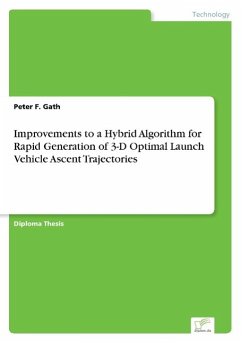
Improvements to a Hybrid Algorithm for Rapid Generation of 3-D Optimal Launch Vehicle Ascent Trajectories
Versandkostenfrei!
Versandfertig in 1-2 Wochen
38,00 €
inkl. MwSt.

PAYBACK Punkte
0 °P sammeln!
Diploma Thesis from the year 1998 in the subject Engineering - Aerospace Technology, grade: 1,0, University of Stuttgart (Luft- und Raumfahrttechnik, Flugmechanik und Flugregelung), language: English, abstract: Inhaltsangabe:Abstract:This thesis presents improvements to FLOAT, a hybrid analytical/numerical algorithm for rapid generation of three dimensional, optimal launch vehicle ascent trajectories. Improvements have been made to the terminal constraints, which are now available in a more general form to allow for an optimal attachment point to the target orbit.The existing algorithm also ha...
Diploma Thesis from the year 1998 in the subject Engineering - Aerospace Technology, grade: 1,0, University of Stuttgart (Luft- und Raumfahrttechnik, Flugmechanik und Flugregelung), language: English, abstract: Inhaltsangabe:Abstract:
This thesis presents improvements to FLOAT, a hybrid analytical/numerical algorithm for rapid generation of three dimensional, optimal launch vehicle ascent trajectories. Improvements have been made to the terminal constraints, which are now available in a more general form to allow for an optimal attachment point to the target orbit.The existing algorithm also has been extended with logic that allows for vehicles with low thrust to weight ratios in the upper stage and successful convergence of problems with path constraints for normal force and angle of attack Another major extension made to the code is the introduction of coasting arcs. Coasting arcs are implemented using a completely analytical solution for the prediction of states and costates as well as for the required sensitivity matrix. This allows for a very fast and accurate calculation even with long coasting arcs.
Finally, an approach for the optimization of start and end time of coast arcs is presented.This approach was implemented and the results of a test case compare very well with results generated with OTIS for the same case.
At the end, suggestions for future development are made.
Inhaltsverzeichnis:Table of Contents:
Summaryi
Acknowledgementsii
Contentsiii
Nomenclaturev
Figuresviii
Introduction1
1.Problem description3
1.1Describing the final orbit3
1.2Coordinate frame5
1.3Dynamic system6
1.4Initial conditions7
1.5Path constraints7
1.6Performance index7
1.7Terminal constraints8
1.8Solution method8
1.9Non-dimensionalization of the variables9
2.Solving the two-point boundary value problem10
2.1Vacuumsolution10
2.1.1Simplified model equations10
2.1.2Optimal control for vacuum solution11
2.1.3Thrust integrals and closed form solution for ascent in vacuum12
2.2Atmospheric solution13
2.2.1Dynamic system and collocation variables13
2.2.2Optimality condition to solve for 1b14
2.2.3Differential equations for the costate variables16
2.3Terminal constraints16
2.3.1Attaching at perigee17
2.3.2Free attachment point17
2.4Transversality conditions18
2.4.1Final costates for attaching at perigee18
2.4.2Final costates for free attachment point19
2.4.3Equatorial orbits22
2.5Adjusting final time22
2.6Computation procedure23
2.7Numerical results24
3.Low thrust upper stages27
3.1Typical low thrust case27
3.2Problems with low thrust upper stages28
3.3Upper stage modification30
3.4Advantage of free attachment point for low thrust upper stage vehicles32
4.Path constraints33
4.1Axial acceleration constraint33
4.2Normal force constraint34
4.3Angle of attack constraint35
4.4Additional homotopy phase to introduce constraints37
5Coast arcs38
5.1Propagating states38
5.2Propagating costates43
5.3Adjusting coast arc position and duration45
5.3.1Optimizing coast arc duration46
5.3.2Optimizing start and end time of coast arc48
5.3.3Optimizing n optimal burn arcs49
5.3.4Inserting additional coast arcs51
6.Numerical results with coast arc and suggestions for future improvements53
6.1Ascent to equatorial orbit53
6.2Behavior of Hamiltonian60
6.3Comparison to OTIS results61
6.4Suggestions to improve convergence62
7.Conclusions and recommendations for future work67
References70
Appendix A - Obtaining the derivatives for the free attachment point constraint72
Appendix B - Obtaining the derivatives for the inclination constraint75
Appendix C - Calculation of the ...
This thesis presents improvements to FLOAT, a hybrid analytical/numerical algorithm for rapid generation of three dimensional, optimal launch vehicle ascent trajectories. Improvements have been made to the terminal constraints, which are now available in a more general form to allow for an optimal attachment point to the target orbit.The existing algorithm also has been extended with logic that allows for vehicles with low thrust to weight ratios in the upper stage and successful convergence of problems with path constraints for normal force and angle of attack Another major extension made to the code is the introduction of coasting arcs. Coasting arcs are implemented using a completely analytical solution for the prediction of states and costates as well as for the required sensitivity matrix. This allows for a very fast and accurate calculation even with long coasting arcs.
Finally, an approach for the optimization of start and end time of coast arcs is presented.This approach was implemented and the results of a test case compare very well with results generated with OTIS for the same case.
At the end, suggestions for future development are made.
Inhaltsverzeichnis:Table of Contents:
Summaryi
Acknowledgementsii
Contentsiii
Nomenclaturev
Figuresviii
Introduction1
1.Problem description3
1.1Describing the final orbit3
1.2Coordinate frame5
1.3Dynamic system6
1.4Initial conditions7
1.5Path constraints7
1.6Performance index7
1.7Terminal constraints8
1.8Solution method8
1.9Non-dimensionalization of the variables9
2.Solving the two-point boundary value problem10
2.1Vacuumsolution10
2.1.1Simplified model equations10
2.1.2Optimal control for vacuum solution11
2.1.3Thrust integrals and closed form solution for ascent in vacuum12
2.2Atmospheric solution13
2.2.1Dynamic system and collocation variables13
2.2.2Optimality condition to solve for 1b14
2.2.3Differential equations for the costate variables16
2.3Terminal constraints16
2.3.1Attaching at perigee17
2.3.2Free attachment point17
2.4Transversality conditions18
2.4.1Final costates for attaching at perigee18
2.4.2Final costates for free attachment point19
2.4.3Equatorial orbits22
2.5Adjusting final time22
2.6Computation procedure23
2.7Numerical results24
3.Low thrust upper stages27
3.1Typical low thrust case27
3.2Problems with low thrust upper stages28
3.3Upper stage modification30
3.4Advantage of free attachment point for low thrust upper stage vehicles32
4.Path constraints33
4.1Axial acceleration constraint33
4.2Normal force constraint34
4.3Angle of attack constraint35
4.4Additional homotopy phase to introduce constraints37
5Coast arcs38
5.1Propagating states38
5.2Propagating costates43
5.3Adjusting coast arc position and duration45
5.3.1Optimizing coast arc duration46
5.3.2Optimizing start and end time of coast arc48
5.3.3Optimizing n optimal burn arcs49
5.3.4Inserting additional coast arcs51
6.Numerical results with coast arc and suggestions for future improvements53
6.1Ascent to equatorial orbit53
6.2Behavior of Hamiltonian60
6.3Comparison to OTIS results61
6.4Suggestions to improve convergence62
7.Conclusions and recommendations for future work67
References70
Appendix A - Obtaining the derivatives for the free attachment point constraint72
Appendix B - Obtaining the derivatives for the inclination constraint75
Appendix C - Calculation of the ...






